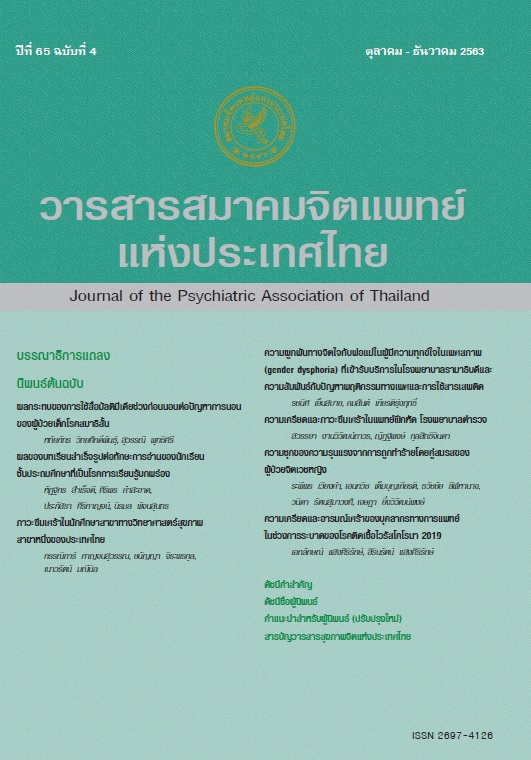Stress and depressed mood in healthcare workers during COVID-19 outbreak
Main Article Content
Abstract
Background: Public healthcare organizations have increased workload due to outbreak of COVID-19. There are panic among peoples. Healthcare workers take risk of infection from patients. This study measures the stress and depression level among healthcare workers to relieve suffering from work.
Method: descriptive cross-sectional study, using ST-5, 9Q scales. Duration from March 2020 to April 2020.
Results: 179 Surin hospital healthcare workers were included, consist of multidisciplinary teams who work associated with COVID-19 from varies department; Cohort ward, Single room, Lab investigation, Disease control, PCC, CEO. Average overtime period is 2.51 ± 2.55 periods per week. Repeated measure 3 times, 2 weeks duration apart. This study reveals that 41.9% got moderate to severe stress in first measurement then down to 36.46%, 25.93% on second and third measurement respectively. The disease control is the most stress department (71%), Cohort ward (70%) and Lab investigation (47.37%)
Conclusion: Healthcare workers who work associated with COVID-19 have more stress and depressed mood than normal population (General population stress 19.5%, depression 0.5%). However, the stress and depression decrease level when repeated measure.
Article Details
Articles submitted for consideration must not have been previously published or accepted for publication in any other journal, and must not be under review by any other journal.
References
1. Cheng ZJ et al. 2019 Novel Coronavirus: where we are and what we know. Infection. 2020 Feb 18. doi: 10.1007/s15010-020-01401-y. [Epub ahead of print] Review.
2. Maxman A. More than 80 clinical trials launch to test coronavirus treatments. Nature. 2020 Feb;578(7795):347-348. doi: 10.1038/d41586-020-00444-3.
3. Watts CH et al. Coronavirus: global solutions to prevent a pandemic. Nature. 2020 Feb;578(7795):363. doi: 10.1038/d41586-020-00457-y.
4. Peng Zhou, Xing-Lou Yang, Xian-Guang Wang, Ben Hu, Lei Zhang, Wei Zhang, Hao-Rui Si, Yan Zhu, Bei Li, Chao-Lin Huang, Hui-Dong Chen, Jing Chen, Yun Luo, Hua Guo, Ren-Di Jiang, Mei-Qin Liu, Ying Chen, Xu-Rui Shen, Xi Wang, Xiao-Shuang Zheng, Kai Zhao, Quan-Jiao Chen, Fei Deng, Lin-Lin Liu, Bing Yan, Fa-Xian Zhan, Yan-Yi Wang, Geng-Fu Xiao, Zheng-Li Shi. Discovery of a novel coronavirus associated with the recent pneumonia outbreak in humans and its potential bat origin. https://www.biorxiv.org/content/10.1101/2020.01.22.914952v1.full
5. https://www.si.mahidol.ac.th/sidoctor/e-pl/admin/article_files/1410_1.pdf
6. Zhao S, Lin Q, Ran J, Musa SS, Yang G, Wang W, Lou Y, Gao D, Yang L, He D, Wang MH. Preliminary estimation of the basic reproduction number of novel coronavirus (2019-nCoV) in China, from 2019 to 2020: A data-driven analysis in the early phase of the outbreak. Int J Infect Dis. 2020 Mar;92:214-217. doi: 10.1016/j.ijid.2020.01.050. Epub 2020 Jan 30.
7. Kampf G, Todt D, Pfaender S, Steinmann E. Persistence of coronaviruses on inanimate surfaces and their inactivation with biocidal agents. J Hosp Infect. 2020 Mar;104(3):246-251. doi: 10.1016/j.jhin.2020.01.022. Epub 2020 Feb 6.
8. Cheng PK, Wong DA, Tong LK, Ip SM, Lo AC, Lau CS, Yeung EY, Lim WW. Viral shedding patterns of coronavirus in patients with probable severe acute respiratory syndrome. Lancet. 2004 May 22;363(9422):1699-700.
9. Holshue ML, DeBolt C, Lindquist S, Lofy KH, Wiesman J, Bruce H, Spitters C, Ericson K, Wilkerson S, Tural A, Diaz G, Cohn A, Fox L, Patel A, Gerber SI, Kim L, Tong S, Lu X, Lindstrom S, Pallansch MA, Weldon WC, Biggs HM, Uyeki TM, Pillai SK. First Case of 2019 Novel Coronavirus in the United States. N Engl J Med. 2020 Mar 5;382(10):929-936. doi: 10.1056/NEJMoa2001191. Epub 2020 Jan 31.
10. https://www.ph.mahidol.ac.th/news/covid19/Edited_COVID-19%20by-DDC-MOPH.pdf
11. Van Doremalen N, Bushmaker T, Munster VJ. Stability of Middle East respiratory syndrome coronavirus (MERS-CoV) under different environmental conditions. Euro Surveill. 2013 Sep 19;18(38). pii: 20590.
12. William A., David J. Guideline for Disinfection and Sterilization in Healthcare Facilities, 2008; Update May 2019 https://www.cdc.gov/infectioncontrol/pdf/guidelines/disinfection-guidelines-H.pdf
13. http://ddc.moph.go.th/viralpneumonia/file/g_other/g41.pdf
14. http://www.who.int/emergencies/disease/novel-coronavirus-2019/
15. Lovibond SH. Lovibond PF. Manual for the Depression Anxiety Stress Scales. 2d ed. Sydney: Psychology Foundation of Australia; 1995.
16. Jianbo Lai, Simeng Ma, Ying Wang, Zhongxiang Cai. Factors Associated with Mental Health Outcomes Among Health Care Workers Exposed to Coronavirus Disease 2019. JAMA Net Open. 2020 Mar 2;3(3): e203976. doi: 10.1001/jamanetworkopen.2020.3976.
17. Chen-Yun Liu, Yun-Zhi Yang, Xiao-Ming Zhang, Xinying Xu. The Prevalence and Influencing Factors in Anxiety in Medical Workers Fighting COVID-19 in China: A Cross-Sectional Survey, Epidemiol Infect. 2020 May 20;148: e98. doi: 10.1017/S0950268820001107.
18. Brymer, M., Jacobs, A., Layne, C.,Pynoos, R., Ruzek, J., Steinberg, A., Watson, P. (2006). Psychological first aid: Field operations guide. National Child Traumatic Stress Network and National Center for PTSD.
19. Tait Shanafelt, MD1; Jonathan Ripp, MD, MPH2; Mickey Trockel, MD, PhD, Author Affiliations Article Information JAMA. Published online April 7, 2020.


